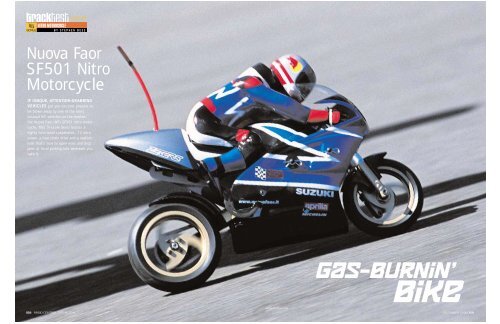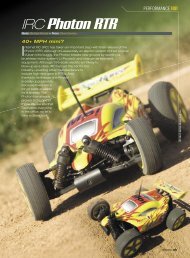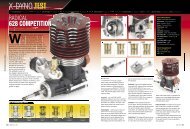Gas-burnin' - Gotnitro Online
Gas-burnin' - Gotnitro Online
Gas-burnin' - Gotnitro Online
Create successful ePaper yourself
Turn your PDF publications into a flip-book with our unique Google optimized e-Paper software.
tracktest >>><br />
1/5 NITRO MOTORCYCLE<br />
SCALE<br />
BY STEPHEN BESS<br />
Nuova Faor<br />
SF501 Nitro<br />
Motorcycle<br />
IF UNIQUE, ATTENTION-GRABBING<br />
VEHICLES get you excited, prepare to<br />
be blown away by one of the most<br />
unusual RC vehicles on the market:<br />
the Nuova Faor (NF) SF501 nitro motorcycle.<br />
This 1 ⁄5-scale beast boasts a<br />
highly functional suspension, .12 nitro<br />
power, a true chain drive and a realistic<br />
look that’s sure to open eyes and drop<br />
jaws at local parking lots wherever you<br />
take it.<br />
<strong>Gas</strong>-burnin’<br />
bike<br />
158 RADIO CONTROL CAR ACTION<br />
PHOTOS BY JASON SAMS<br />
DECEMBER 2003 159
TRACK TEST NUOVA FAOR SF501 NITRO MOTORCYCLE<br />
KIT FEATURES<br />
CHASSIS. The Nuova Faor SF501 motorcycle’s twin stamped-aluminum<br />
plates are connected with large plastic spacers. The bike’s basic rigid, light<br />
frame structure allows the radio gear and small-block .12 engine to be<br />
positioned for ideal balance. A large rectangular balance weight is<br />
attached to the lower chassis plate and close to the fuel tank to balance<br />
the cycle when it’s upright. The cycle’s large, metal fuel tank—the heaviest<br />
component when it’s full—is mounted on the frame’s lowest point where<br />
it stabilizes the bike when it’s running.<br />
DRIVE TRAIN. An incredibly realistic chainand-sprocket<br />
drive train propels the bike. The<br />
SF501 engine’s clutch bell (which houses a 2-<br />
shoe clutch with a wraparound spring) is<br />
mated with a large, machined-steel spur gear<br />
that’s attached to a steel shaft with a small<br />
sprocket at the other end. The drive chain<br />
wraps around this small sprocket and is<br />
attached to the cycle’s main drive sprocket at<br />
the rear wheel. An adjustable chain tensioner<br />
is built into the rear swing arm. The front<br />
wheel has a single fiber disc brake that’s<br />
clamped with two metal pads that are<br />
actuated by a long control wire.<br />
SUSPENSION AND STEERING. Up front, the<br />
cycle’s scale-looking, dual-fork front suspension has two friction dampers.<br />
The front shafts are inserted into the lower tubes and damped by stiff<br />
springs at the base of these tubes. Nuova Faor recommends that you pour<br />
a few drops of shock oil into the tubes to smooth suspension action, but<br />
the front forks are not oil-filled shock absorbers. The bike’s one-sided rear,<br />
swing-arm suspension pivots on an inner hinge and is damped with one,<br />
aluminum-body, coil-over shock absorber. This comes filled with shock<br />
fluid of an undisclosed viscosity, and it provides excellent damping. To<br />
steer the bike, a simple pushrod system connects the steering-servo horn<br />
to the front, pivoting, steering assembly. The box-stock system has a short<br />
piece of fuel tubing connected to the steering-servo horn as a<br />
damping/servo-saver type assembly, but at the distributor’s suggestion, I<br />
chose to install NF’s optional spring-loaded servo-saver system.<br />
Bike-handling basics<br />
Driving an RC motorcycle is not the same as driving an RC car.<br />
With a car, you turn the transmitter wheel to the left to turn the<br />
front wheels to the left. With the bike, the opposite is true: its<br />
front wheel turns in the opposite direction to the radio input. Just<br />
flip the servo-reversing switch so that when you turn the steering<br />
wheel on the transmitter to the left, the Cycle also goes left even<br />
though the wheel will be physically turning to the right.<br />
Turn the transmitter wheel until the bike leans and turns at<br />
the desired rate; then return the wheel to the neutral position<br />
and it will continue to turn. Applying throttle or brake alters its<br />
turning radius. If you squeeze the trigger for more throttle, the<br />
bike will stand up and go straight; conversely, applying brake<br />
tightens the radius. If you don’t alter the throttle settings at all,<br />
you’ll have to turn the transmitter wheel in the opposite direction<br />
to get the bike to come out of a turn.<br />
160 RADIO CONTROL CAR ACTION<br />
When it isn’t on the track, the SF501 makes a greatlooking<br />
display model, and the included aluminum stand<br />
holds the bike upright.<br />
ENGINE AND ACCESSORIES. The bike doesn’t include an engine, and the<br />
field of potential candidates is a little thin because of th precise fit requirements<br />
of the bike. Fortunately, NF offers a Novarossi engine made specifically<br />
for this motorcycle; it’s a .12 pull-start with a slide carb, a threaded shortshaft<br />
crankshaft and a side exhaust. It’s very powerful and fits the bill perfectly,<br />
so that’s what I installed. A long, scale-looking aluminum tuned pipe<br />
and rubber coupler are included, and so is a metal fuel tank. On the top of<br />
the tuned pipe, there’s a fitting that pressurizes the tank for consistent fuel<br />
delivery. A fitting on the bottom of the pipe<br />
has no apparent purpose except perhaps to<br />
drain away excess oil and fuel residue; if this<br />
is the case, you’d have to attach a length of<br />
fuel line to it or oil and exhaust residue will be<br />
blown all over the swing arm.<br />
BODY, WHEELS AND TIRES. A molded Lexan<br />
body and a driver figure complete the scale<br />
look. I sent them both off to Bill Zegers of<br />
Zegers Graffix for a replica 2003 Suzuki GP<br />
team paint job, and the results speak for themselves.<br />
The body alone gives the bike a perfect<br />
scale appearance, but the two-piece molded<br />
driver could have been molded better. I joined<br />
the halves with servo tape and attached the<br />
driver to the seat; use tape or glue to do this.<br />
To protect the body during a crash, large<br />
wire nerf bars are included, but they detract from the bike’s scale appearance,<br />
so install them only when you plan to run it. Large, 3-spoke aluminum<br />
wheels and treaded rubber tires with foam inserts are included.<br />
BUILDING & SETUP TIPS<br />
The SF501 isn’t an easy build for<br />
first-timers, as several assembly<br />
steps are vaguely described or<br />
incomplete. These tips will help<br />
guide you in the right direction, and<br />
if you already have some building<br />
experience, things should go fine.<br />
STEERING LINKAGE. The<br />
SF501’s stock steering linkage has<br />
a short piece of fuel tubing to act<br />
as a steering “servo-saver.” At<br />
Internet R/C’s suggestion, I<br />
replaced this with the optional<br />
spring steering support (item no.<br />
X80A); it provides more precise,<br />
predictable steering.<br />
BODY ASSEMBLY. The instruction<br />
manuals skip the body- and<br />
driver-mounting steps. Trim the<br />
motorcycle body so that the spur<br />
gear and clutch bell are exposed; if<br />
you don’t, the gears will grind into<br />
the Lexan body so the drive train<br />
won’t be able to spin smoothly.<br />
Also, trim the driver pieces carefully,<br />
and test-fit them together before<br />
you trim away important pieces. The<br />
body doesn’t have molded-in trim<br />
lines, so you’ll have to use your<br />
best judgment and remove a little<br />
Lexan at a time until the driver fits<br />
properly.<br />
RECEIVER AND RECEIVER<br />
BATTERY. The SF501’s instruction<br />
manual doesn’t tell you how and<br />
where to mount these; I mounted<br />
the Novak micro receiver on the<br />
right rear of the chassis (opposite<br />
the exhaust pipe). Secure the<br />
receiver battery underneath the<br />
chassis with double-sided servo<br />
tape and a few pieces of strapping<br />
tape or electrical tape.<br />
you’ll need<br />
■ Transmitter & receiver<br />
■ Steering & throttle servos<br />
■ Fuel & fuel bottle<br />
■ Glow igniter<br />
■ Thread-lock compound<br />
■ Receiver battery<br />
■ Polycarbonate-friendly paint<br />
■ CA glue<br />
factory options<br />
■ Titanium muffler—item<br />
no. X226<br />
■ 3-point clutch—X215<br />
■ Metal front disc brake in with<br />
metal and Ferodo brake<br />
pads—X115/X114<br />
■ Steering support with springs<br />
for steering rod—X80A<br />
■ Motorcycle carrying<br />
case—X106<br />
The silver spring acts as<br />
an additional front-end<br />
shock absorber, and the<br />
steering damper<br />
(arrowed) soaks up any<br />
bumps that might knock<br />
the front wheel offcourse.<br />
Below: the clutch bell sticks out on the right side of the frame<br />
and is mated with the machined-steel spur gear. When the<br />
motorcycle is running, the heavy, metal fuel tank and a weight<br />
on the frame’s lowest point enhance stability.<br />
Right: the realistic-looking rear end features an authentic metal<br />
chain and a one-sided swing arm where the rear sprocket is<br />
mounted. The screw that’s indicated by an arrow is used to<br />
adjust chain tension.<br />
SPECIFICATIONS<br />
MANUFACTURER Nuova Faor<br />
MODEL SF501<br />
DISTRIBUTOR Internet R/C<br />
SCALE 1 ⁄5<br />
PRICE $500<br />
Varies with dealer<br />
DIMENSIONS<br />
Wheelbase 11.8 in. (300mm)<br />
Width 4.75 in. (120mm)<br />
Length 16 in. (406mm)<br />
WEIGHT<br />
Total, as tested 73.2 oz. (2,075g)<br />
CHASSIS<br />
Type Twin-plate box frame<br />
Material Stamped aluminum<br />
DRIVE TRAIN<br />
Type Chain drive<br />
Primary Clutch bell/spur<br />
Bearing type Metal-shielded ball<br />
bearings<br />
SUSPENSION<br />
Type (F/R) Inverted fork/one-sided<br />
swing-arm<br />
Damping (F/R) Friction/coil-over,<br />
aluminum oil-filled<br />
WHEELS<br />
Type 4-spoke anodized-aluminum<br />
TIRES<br />
Type Treaded rubber<br />
ENGINE AND ACCESSORIES<br />
Engine (not included) Nuova<br />
Faor/Novarossi CX12<br />
w/pull-start<br />
Carb Twin-needle slide<br />
Exhaust Aluminum tuned pipe<br />
Fuel capacity 80cc<br />
NOVEMBER 2003 161
TRACK TEST NUOVA FAOR SF501 NITRO MOTORCYCLE<br />
PERFORMANCE<br />
After scoping out an empty, freshly paved<br />
mall parking lot, I set up my gear and fired<br />
up the engine. It’s best to break the engine<br />
in and get its needle settings dialed in to<br />
allow it to idle well before you install the<br />
body; if you don’t, you’ll constantly have to<br />
remove and reinstall the body to get to the<br />
pull-start mechanism. Luckily, the .12<br />
easily holds an excellent idle when given a<br />
decent tuning.<br />
Acceleration is astounding, and with<br />
1hp on tap, it’s almost possible to pull<br />
wheelies when traction is ideal and the<br />
engine has been tuned for maximum performance.<br />
Braking is another issue, especially<br />
if you haven’t set up the brake system<br />
properly; if you don’t have a delicate<br />
brake-trigger finger, you’ll find it difficult<br />
to bring the bike to a safe stop. If you lock<br />
up the front wheel, you’ll instantly skid<br />
and be wrecked, but with practice, coming<br />
to a controlled, gradual stop is easy.<br />
The bike runs best when it’s allowed to<br />
make gradual sweeping turns and direction<br />
changes; if you alter course abruptly,<br />
you risk toppling it and losing control.<br />
Luckily, the wire nerf bars protect its sides.<br />
Don’t expect to weave through tight spots<br />
until you have had plenty of wheel time<br />
with it, and even then, you’ll find it difficult<br />
to pull off a sharp leaning turn without<br />
scraping its sides. Learning to drive it presents<br />
a challenge that’s similar to learning<br />
to ride a full-size bike. After feeling awkward<br />
for a few tanks of fuel, you’ll get a<br />
feel for how it handles, and from then on,<br />
driving it will come naturally.<br />
It’s easy to forget that you’re driving an RC motorcycle as you lean into corners and blast out of them. The bike’s<br />
motions mimic those of a full-size bike in every way, with the possible exception of its speed-to-size ratio: I estimate<br />
its top speed to be 45mph—like 225mph on a full-size bike. Oh; and get ready to make plenty of new friends<br />
because a large, nitro-powered RC motorcycle draws more attention than any 4-wheeler ever could.<br />
THE VERDICT<br />
The Nuova Faor nitro motorcycle presents several assembly and driving challenges, but given some attention to<br />
detail, it will reward its owners by being a unique, scale-looking RC vehicle that delivers speed and fun in large<br />
doses. I’m especially fond of its incredible acceleration and how it looks when it scoots through a parking-lot<br />
course. It’s unlike any RC vehicle I’ve driven in my 16 years of RC. It isn’t cheap, and its assembly is challenging,<br />
but the Nuova Faor Nitro Motorcycle delivers a true-to-scale appearance and a high-speed performance that will<br />
make any experienced RC guy overlook such minor details and enjoy it for exactly what it is: a fast, fun departure<br />
from the every day 4-wheel RC car.<br />
RATING THE NUOVA FAOR SF501 NITRO MOTORCYCLE<br />
POOR FAIR GOOD VERY GOOD EXCELLENT<br />
INSTRUCTIONS<br />
PARTS FIT & FINISH<br />
CORNERING ABILITY<br />
ACCELERATION<br />
DURABILITY<br />
ESTIMATED TOP SPEED<br />
* Top speed varies with equipment used.<br />
CAD drawings are a plus, but several steps aren’t clearly described.<br />
The machined and stamped parts are well finished, but the Lexan body and driver figure could have been molded better.<br />
The SF501 corners very well for a motorcycle, and on smooth surfaces, it’s easy to balance.<br />
The bike’s lightness with the Novarossi/NF .12 engine equals rocket-like acceleration.<br />
With the included nerf wings installed, the bike takes plenty of abuse and stays in one piece.<br />
45MPH*<br />
BEST BUYER<br />
Experienced builders who love scale looks and high performance.<br />
LIKES<br />
> True-to-scale appearance.<br />
> One of the most unusual<br />
RC vehicles on the<br />
market.<br />
> Astounding acceleration<br />
and top speed.<br />
DISLIKES<br />
> Time-consuming assembly<br />
following two manuals.<br />
> Minor parts fit and quality<br />
problems.<br />
> Molded-Lexan rider figure<br />
isn’t realistic.<br />
TEST GEAR<br />
Futaba 3PDF transmitter<br />
The 3PDF’s glitch-resistant<br />
FM signal is perfect for nitropowered<br />
vehicles, and its<br />
digital trims make dialing in<br />
your settings a snap.<br />
Other items used to complete<br />
the SF501:<br />
Novak XXL receiver<br />
Novarossi/Nuova Faor<br />
CX12 pull-start engine<br />
Airtronics 94102<br />
standard servos<br />
O’Donnell 20%-nitro fuel<br />
sources<br />
AIRTRONICS (714) 978-1895;<br />
airtronics.net.<br />
DURATRAX/O’DONNELL<br />
distributed by Great Planes<br />
Model Distributors<br />
(217) 398-6300; (800)<br />
682-8948;<br />
duratrax.com.<br />
FUTABA distributed exclusively<br />
by Great Planes Model<br />
Distributors Co. (217) 398-6300;<br />
(800) 682-8948; futaba-rc.com.<br />
NOVAK ELECTRONICS INC.<br />
(949) 833-8873;<br />
teamnovak.com.<br />
NOVAROSSI distributed<br />
exclusively by Trinity Products<br />
Inc. (732) 635 1600;<br />
teamtrinity.com.<br />
NUOVA FAOR distributed by<br />
Internet R/C (602) 347-1600;<br />
internet-rc.com.<br />
ZEGERS R/C GRAFFIXX<br />
(561) 988-5411.<br />
162 RADIO CONTROL CAR ACTION





